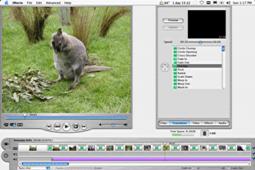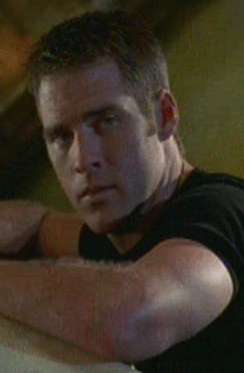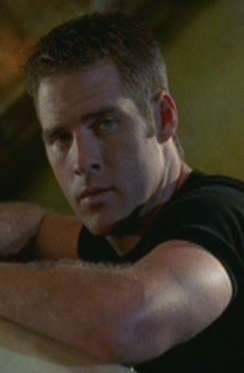

Back when I was getting serious about digital photography, somewhere around camera number two or maybe number three, a couple of my colleagues had already abandoned still photography for the wonderful world of digital video. This was the time of the first pocket sized video cameras, marvels of miniaturization whose prices rivaled that of my first new car. But I wasn't intimidated. Nossir. I knew just enough about film and video to know I had neither the talent nor the patience for it. Besides, I was becoming pretty good with a still camera. Why start at square one with a new medium?
Seven years later I'm finally excited by the possibilities of digital video. But not as a cameraman; my limited experiments thus far seem to indicate that I'm every bit as inept as I'd feared. No, for me the excitement of video is in editing.
What follows is a tale of adventure in making music videos, which I hope you will find entertaining or educational or both. But if you really don't care about that and just want to see the videos, here are quick links. I have both large and small, lower quality versions of each video. You'll need the latest version of Apple's Quicktime Player to view them.
|
||||
And if after all that you're still in the mood for more videos, take a wander over to Farscape Fantasy. DallasScaper has the biggest collection anywhere. Many of these videos use Microsoft's WMV video format, for which there is finally a compatible player for Mac OS X. If you download a WMV file and can't play it on your Mac, head over to the ironically named Mactopia and download yourself a copy.
 My foray into video began innocently enough. My
director at Apple mentioned that he was
using the free iMovie software that
comes with the Mac to make slide shows of some of his digital pictures.
I was surprised that he wasn't using
iPhoto, which does a nice job of
slide shows and even lets you add a music track to the presentation. But he
explained that iMovie gave him more control over the presentation and the
synchronization of audio and images.
My foray into video began innocently enough. My
director at Apple mentioned that he was
using the free iMovie software that
comes with the Mac to make slide shows of some of his digital pictures.
I was surprised that he wasn't using
iPhoto, which does a nice job of
slide shows and even lets you add a music track to the presentation. But he
explained that iMovie gave him more control over the presentation and the
synchronization of audio and images.
That got me thinking. And when I got home I decided to have a little fun
with iMovie.
Without bothering with little things like reading any documentation, I was
able to import a bunch of pictures from my Australian
holiday and make a movie out of them.
Once I had the pictures in the order I wanted and made the tough decision about just how long to leave each on on the screen (five seconds, if you must know), I tossed in a soundtrack by importing a track from a CD. I then figured out iMovie's transitions, moving from picture to picture by fading from one to the next. Less than an hour after I began, I was done. The last step was to convert the movie into a QuickTime file, so I could show off my cleverness to all my friends:
(Even in these high bandwidth times, video on the web involves trading off file size, resolution and picture and sound quality. If the movie is too demanding for your network connection, I have a lower resolution 5.2 MB version available. And if you can't get the QuickTime plugin to work, you can download the 16.9 MB movie.)
Even as I was putting my little slide show together, I knew what I really wanted to do. At the 2001 Farscape convention, I'd been impressed by some music videos created by a few of the show's more devoted fans. (And a reminder that the word fan is derived from fanatic.) It seemed simple enough: find a song and then collect a bunch of clips from the show that have some relation to that song.
So with just over a month to go before the 2002 convention, I wondered if I could produce something half so good. I started by researching digital video cameras, settling quickly on Canon's ZR40. With the videocam's ability to take analog video (say, from my stash of Farscape DVDs), convert it to digital and then feed it to my PowerBook over Firewire, I'd have all the raw material I'd need for my video experiments.
Ah, but what about copy protection, I hear you cry. What about Macrovision and their determination to bugger up any video signal so VCRs get heartburn? Here's a funny little fact: lots of DVDs don't bother with Macrovision. It turns out that if you do use it, you have to pay them a fee for every disk you ship. And plenty of DVD makers, ADV among them, don't think the cost is worth the benefit. So there was nothing to keep me from feeding the video from my DVD player into my camcorder and thence to my Mac.
Well, that was the theory. I should have known it wouldn't be so simple. I hadn't allowed for collusion between content providers and electronics manufacturers. It turns out that DVDs put out a little signal to indicate that the content is copy protected. And my brand new camcorder timidly throws up its little electronic hands when it sees that signal. So no video for Hank.
I did get one bit of joy from the camcorder, though. I told iMovie to export my Australia video to tape and admired the result on the ZR40's cute little flip-out screen. Then I plugged the camcorder into my television. I know it's silly. But having grown up on the receiving end of a Glass Teat, I experienced an incredible shiver of accomplishment to have something of mine onscreen.
But back to my music video efforts. A little setback like this wasn't going to stop me. It was back to the Internet for some more research, this time into analog/digital converters. There were a few models in the right price range and with the right features. Now the only question was whether any of these devices had the kind of annoying copy prevention that kept me from doing what I wanted.
I didn't find a definite answer. But I found what might be one, in a negative kind of way. One article that compared A/D converters took points away from Sony's product because it had copy prevention. So, using elementary logic, I concluded that any of the others would satisfy my most important requirement. I settled on the Formac Studio DV, which I ordered posthaste.
And yes, in case you're curious, the Formac Studio does a pretty fair job of capturing analog video from a DVD player and feeding it to my Powerbook. This time I wasn't paying extra to be prevented from doing what I liked with some disks I'd bought fair and square. (Bitter? Moi? Ha!)
With the technical issues out of the way, it was time to get serious. The first challenge was picking the right song. I'd been thinking long and hard about this one while waiting first for my camcorder and then for the A/D. I'd finally had what felt like an inspiration: one of the most haunting performances I'd heard in a long time.
I discovered Eva Cassidy while searching the net for interesting MP3s. I'd been looking for Louis Armstrong's performance of What A Wonderful World, which I'd first heard at the end of The Hitchhiker's Guide To The Galaxy. But my search turned up an unexpected bonus: the late Ms. Cassidy's cover of this lovely tune. The more I thought about it, the more I wanted to put something together to complement this performance.
(I think it's worth pointing out I now own four of
Eva Cassidy's CD, for which I paid real
money. And that I'd never have known about her if it weren't for those evil
file sharing networks that the music labels are determined to kill. But
I digress.)
Back in iMovie, I dropped my music track into my project. Then I started playing all my Farscape DVDs, fast forwarding until I spotted a clip I might be able to use. When I found one, I'd back up to a few seconds before the bit I wanted, tell iMovie to start importing video and then get the DVD playing again. With the clip installed in iMovie, I'd edit out the parts I didn't want and drop the good stuff into the timeline. Then came the fun part: moving clips around, cutting in different ways (and appreciating the wonderfulness of the Undo command) and playing the video until I got something I liked. And then the whole cycle began again.
One lesson I learned from this exercise is to look very carefully at the first frame of a clip before trying to use it. Each frame of NTSC video (1/30 of a second) actually consists of two interlaced frames. When I would take a piece of video and split it at changes in scene or camera angle, the two interlaced frames wouldn't always match up. So the freeze frame would look rough. Or the little thumbnail picture in iMovie will be half one scene and half the other, as you can see in the left hand column:
| A noisy transitional frame | One frame later |
|---|---|
 |
 |
 |
 |
The fix is simple. Just trim off the first frame after a transition. I didn't always notice one of these symptoms. Sometimes I didn't catch the problem until after I'd transferred the video to tape. Then there would be a flash of something I didn't want in the transition between clips.
It took me a week's worth of evenings to complete my five minute video. That included recreating a couple of clips, which I'd edited too short or cut together in a way I didn't entirely like. And it also included high speed viewing of all of Farscape's season one and the first half of season two. But I think the results were worth the effort:
(You can download the 37.2 MB file. And there's a lower quality 6.8 MB version if you have neither a high speed connection nor inordinate amounts of patience.)
The story continues on the next page...
Comments to: Hank Shiffman, Mountain View, California